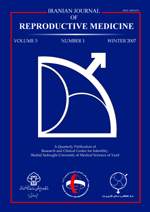
|
International Journal of Reproductive BioMedicine
Research and Clinical Center for Infertility, Shahid Sadoughi University of Medical Sciences of Yazd
ISSN: 1680-6433
EISSN: 1680-6433
Vol. 16, No. 11, 2018, pp. 665-678
|
 Bioline Code: rm18081
Bioline Code: rm18081
Full paper language: English
Document type: Review Article
Document available free of charge
|
|
|
International Journal of Reproductive BioMedicine, Vol. 16, No. 11, 2018, pp. 665-678
| en |
The prevalence of menstrual disorders in Iran: A systematic review and meta-analysis
Samani, Reza Omani; Hashiani, Amir Almasi; Razavi, Maryam; Vesali, Samira; Rezaeinejad, Mahroo; Maroufizadeh, Saman & Sepidarkish, Mahdi
Abstract
Background: Understanding the prevalence of menstrual disorders has important
implications for both health service planning and risk factor epidemiology.
Objective: The aim of this review is to identify and collate studies describing the
prevalence of menstrual disorders in Iran.
Materials and Methods: Studies with original data related to the prevalence of
menstrual disorders were identified via searching six electronic databases and
reviewing citations. All abstracts or titles found by the electronic searches were
independently scrutinized by two reviewers. The Meta-analysis was performed with
a random effects model, considering the remarkable heterogeneity among studies. A
total of 35 eligible epidemiological studies were included in this review.
Results: Overall, the pooled prevalence of primary dysmenorrhea was 73.27% (95%
CI=65.12-81.42). The mean proportion of women with oligomenorrhea was 13.11%
(95.5%, 95% CI: 10.04-16.19). We identified 16 studies that reported
polymenorrhoea with a random effect of pooled prevalence estimate of 9.94% (95%
CI 7.33%-12.56%). The prevalence estimate of hypermenorrhea was 12.94% (95%
CI 9.31%-16.57%). Overall prevalence of hypomenorrhea was 5.25% (95% CI
3.20%-7.30%), ranging from 0.9- 12.90%. Pooling six studies that reported
estimates for menorrhagia, the overall prevalence was 19.24% (95% CI 12.78-25.69). Overall, 6.04% (95% CI: 1.99-10.08) of the women were shown to have
metrorrhagia.
Conclusion: This systematic review suggests that the average prevalence of
menstrual disorders in Iran is substantial. It has been neglected as a fundamental
problem of women's reproductive health. Diagnosis and treatment of these disorders
should be included in the primary health care system of reproductive health.
Keywords
Menstruation disturbances; Amenorrhea; Dysmenorrhea; Menorrhagia; Oligomenorrhea.
|
| |
© Copyright 2018 - International Journal of Reproductive BioMedicine
Alternative site location: http://www.ijrm.ir
|
|
